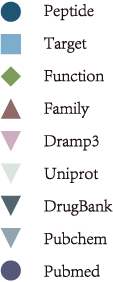(Ace)(Slz)(Ptr)Vnvp
Basic information
| CPKB ID | CP02724 |
| Source |
Synthetic construct [Division : Synthetic]
Wikipedia: Synthetic construct DPL2 |
| Information |
cyclic phosphopeptides containing nonreducible mimics of cystine were synthesized that show high affinity and specificity toward the Src homology (SH2) domain of the growth factor receptor-binding protein (Grb2). Replacement of the cystine in the cyclic heptapeptide cyclo(CYVNVPC) by D-alpha-acetylthialysine or D-alpha-lysine gave cyclo(YVNVP(D-alpha-acetyl-thiaK)) (22) and cyclo(YVNVP(D-alpha-acetyl-K)) (30), which showed improved binding 10-fold relative to that of the control peptide KPFYVNVEF (1). |
Legend

Sequence
| One-letter code |
(ACE)(SLZ)(PTR)VNVP |
Binding Target
Detail
Uniprot: P62993
Kind: Protein>Protein domain
Organism: Homo sapiens(Human)
Evidevce: DPL2 DPL2
Sequence: MEAIAKYDFKATADDELSFKRGDILKVLNEECDQNWYKAELNGKDGFIPKNYIEMKPHPWFFGKIPRAKAEEMLSKQRHDGAFLIRESESAPGDFSLSVKFGNDVQHFKVLRDGAGKYFLWVVKFNSLNELVDYHRSTSVSRNQQIFLRDIEQVPQQPTYVQALFDFDPQEDGELGFRRGDFIHVMDNSDPNWWKGACHGQTGMFPRNYVTPVNRNV
General Function:
Sh3/sh2 adaptor activity
Specific Function:
The growth factor receptor-binding (Grb2) adaptor protein plays a central role in signaling by receptor tyrosine kinases. Grb2 is necessary for activation of the Ras pathway via complex formation with the Ras exchange factor Sos. 2 The Src homology (SH2) domain of Grb2 binds preferentially to phosphotyrosines (Y*s) with the sequence motif Y*XNX. The two SH3 domains of Grb2 bind to Sos, which catalyzes GTP/GDP exchange on Ras, thereby activating the GTPase and downstream kinase cascade.
Additional database information: TTD[SH2 domain of Grb2(1)]
Manufacturers
| Manufacturers Name | Value | |
|---|---|---|
| CreativePeptides | ||
| Bayer healthcare pharmaceuticals | ||
| Upsher smith laboratories | ||
| Merck |
| Manufacturers Name | Value | |
|---|---|---|
| Apotex | ||
| Baxter Healthcare Corp | ||
| Pharmasources | ||
| Novartis | ||
| AstraZeneca |
Forecasting tools
| Forecasting tools | Value | |
|---|---|---|
| Sequence to Structure | ||
| Sequence Properties | ||
| Expasy ProtParam Tool | (ACE)(SLZ)(PTR)VNVP | |
| SEA | RUN SEA Predictions |
Information Source
| Property Name | Property ID | |
|---|---|---|
| Drugbank | ||
| DPL2 | DPL_553 | |
| DRAMP3 | ||
| Uniprot | ||
| Cybase | ||
| CONOSERVER | ||
| CHEMBL | ||
| CTD | ||
| Wikipedia | ||
| KEGG Compound/Drug | ||
| EPA DSSTox | ||
| FDA Global Substance Registration System (GSRS) | ||
| DTP/NCI |
Reference
| Pubmed_ID | Title | DOI | Journal | |
|---|---|---|---|---|
1446006 |
10.1021/tx00029a011. | Chem Res Toxicol |
||
Structures of three new homotyrosine-containing microcystins and a new homophenylalanine variant from Anabaena sp. strain 66Abstract
|
||||
